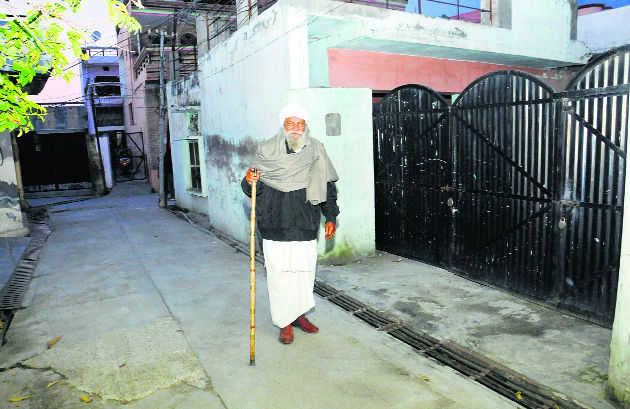
In several Punjab villages, large padlocks hang outside mansions Photos: Malkiat Singh
Darshan S. Tatla
Are Punjab villages shining? You could say ‘yes’ going by the modern overview of a typical village where you can relish the sight of lavish two-storey bungalows amidst all brick-built houses. Go closer and the picture changes. Majority of these mansions are locked; large padlocks hang from their expensive, designer gates. A small side door leads you to a migrant family assigned the job of looking after the house in the owners’ absence, daily cleaning and watering the plants, etc.
Where are the owners, you ask? The answer, of course, is abroad. This is the current state of Punjabi migration with scores of families settled abroad. Such a scene used to be a Doaba thing, but is now the norm across Punjab. What has changed is the way these relate to their houses left behind — by building a spacious bungalow in place of old dwellings. These are impressive edifices, costing lakhs, these monuments for the departed...
Why do they build it if they have no intention to return, much less live in it? It is not a question that can be easily answered. The practice started again in Doaba villages at first; you could see them in Jandiala (Jalandhar district) or Moranwali (Hoshiarpur) as early as the 1980s. Now the practice has spread around to almost every Punjabi village.
Lack of jobs for the educated, corruption everywhere and dismal overall development are the reasons commonly cited. Whatever the excuses, the fact is there is an exodus of youth from Punjab — men and women in the age bracket of 20-25. The means employed today are quite different from the earlier generation though. The most trodden path is the IELTS scheme introduced with the new millennium. And the major destinations are just two developing but under-populated countries. Canada and Australia are now intimately connected to Punjabi villages through IELTS. Thousands of youth have sat through these tests, arranging fees for admission to a college or institute and then find ways towards permanent settlement there. Thus, Greater Vancouver and Metropolitan Toronto are humming with the freshly arrived young Punjabi faces as are cities of Australia — Melbourne, Brisbane, Sydney and several others.
Finally, consider the impact of families leaving their villages in such large numbers. Many schools are on the verge of closing due to lack of pupils. Consider the optimism of the 1950s when the newly independent state of India was keen to spread education to all sections of society. A primary school in almost every village had high schools quite soon after that. My generation passed through these schools, gaining ample qualifications for their careers.
Contrast the contemporary scene: the government schools devoid of the morning hustle and bustle of hundreds of pupils. Today, every village is surrounded by private schools competing for pupils. On six days of the week, different school buses drive into the village lanes where young kids in smart uniforms are waiting to be bussed into different directions — a typical Punjabi village sends its young boys and girls to more than half a dozen schools. Do their parents know about the quality of teaching in those private schools apart from the make-believe advertisements and handbills on the walls?
One could very well ask why Punjab Government decided to abandon two basic functions of any government — providing for education and health. Let us remember it was the Akali Dal-BJP alliance that allowed education to be privatised without caring for its long-term consequences. Anyone familiar with the educational scene in Punjab will attest to the incalculable damage this policy has done to the social fabric of rural society, creating painful divisions based upon family wealth.
What is left of the Punjab village minus its youth? The village may be shining in terms of large mansions, but, in essence, this extravaganza stands as a display of vanity writ large by Sikh peasants who have left their homeland without a second thought.
Beeline for good life
- Country Per cent
- Canada 24.8
- UAE 15.5
- US 13.6
- UK 11.0
- Australia 9.1
- Italy 5.5
- Any Country 25.3
— A CRRID survey
— The writer is senior fellow at World Punjabi Centre, Punjabi University



























